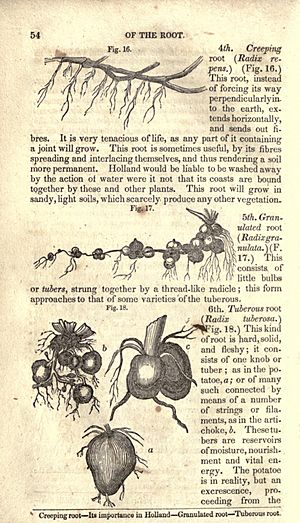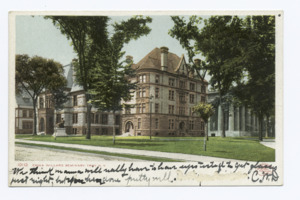Almira Hart Lincoln Phelps facts for kids
Quick facts for kids
Almira Hart Lincoln Phelps
|
|
|---|---|
 |
|
| Born |
Almira Hart
July 15, 1793 Berlin, Connecticut, U.S.
|
| Died | July 15, 1884 (aged 91) Baltimore, Maryland, U.S.
|
| Nationality | American |
| Other names | Almira Hart Lincoln (1817–1831) |
| Occupation | educator, author, editor, scientist |
| Known for | author:
|
| Spouse(s) |
Simeon Lincoln
(m. 1817; died 1823)John Phelps
(m. 1831) |
| Children | Charles E. Phelps |
| Relatives | Emma Hart Willard (sister) |
Almira Hart Lincoln Phelps (born July 15, 1793 – died July 15, 1884) was an important American scientist, teacher, writer, and editor. She helped many young women learn about science. Her writings on botany (the study of plants) encouraged many early American women to become botanists. These women included Eunice Newton Foote and her daughter, Augusta Newton Foote Arnold.
Almira Phelps was from Connecticut. She spent her long life focused on educating young women. She wrote several popular science textbooks about plants, chemistry, and geology. Some of her well-known books include Familiar Lectures on Botany and The Fireside Friend. She also wrote about many other topics, from public speaking to women's fashion.
Contents
Early Life and Learning
Almira Hart was born on July 15, 1793, in Berlin, Connecticut. She was the youngest of 17 children. She grew up in a family that loved learning, thinking for themselves, and religion. Her family lived on a farm, where there was always a lot to do and learn.
Her mother, Lydia, was interested in how bodies work. She would study animals she cooked, which helped her understand basic human anatomy. This knowledge allowed her to help her family and neighbors with simple first aid. Lydia also studied plants and later shared her observations with Almira, who became very interested in botany.
The Hart home was a place where people often gathered to discuss many different topics. Almira's father, Samuel Hart, loved to debate. The children were encouraged to ask questions and form their own opinions. Almira's parents often told stories about their ancestors and family history. Almira especially loved stories about the Revolutionary War. This home environment helped Almira grow up loving to learn and think independently.
Almira had access to many books from a young age through a friendship with an elderly bookseller's mother. She loved to read everything she could find. One of her most important mentors was her older sister, Emma Hart Willard. Emma became a famous reformer of women's education. She advised Almira to choose good books to truly educate herself, not just read for fun.
When Almira was 17, she went to live with Emma and her husband. Her sister was in charge of a school for girls in Middlebury. While living there, Almira also learned from John Willard and his students. She studied mathematics and philosophy. Young men from Middlebury College often stayed with the Willards. This gave Almira a chance to learn subjects that were not usually taught to women at the time. She learned higher mathematics by discussing with these college students.
Her Career as a Teacher and Writer
Almira started teaching in local schools at age 16. She continued her own education as well. In 1814, she opened her first boarding school for young women at her home. Two years later, she became the principal of a school in Sandy Hill, New York.
In 1817, Almira married Simeon Lincoln. She stopped working for six years to be a wife and mother to her three children. After her husband died in 1823, she returned to teaching as "Almira Hart Lincoln." She became a teacher and then, in 1829, the vice-principal at the famous Troy Female Seminary in Troy, New York. This school was run by her sister, Emma Hart Willard.
While teaching at Troy, Almira's interest in science grew. She started her work in botany because of Amos Eaton. As a teacher, Almira noticed there weren't many science books for new college students. She decided to write textbooks that were easy to understand. She wanted to make it simpler for young people, especially young women, to study science.
Science became a popular subject at the Troy Seminary. Almira took her students on field trips to study plants near the school. Her students were very excited about botany. She also became interested in chemistry. When the Troy Seminary added a chemistry lab, Almira made sure it had all the chemicals needed for experiments. She gave lectures on chemistry that included experiments, making science education better at the school.
Amos Eaton and her sister's success encouraged Almira to write textbooks. She also needed money. Her first and most famous textbook, Familiar Lectures on Botany, was published in 1829. It was reprinted many times and sold over 275,000 copies by 1872. Amos Eaton believed women should have higher education. He often invited women from the Troy Seminary to his lectures at Renessalaer Polytechnic Institute. He thought men and women should learn together. Almira learned a lot from Eaton about botany, chemistry, geology, and natural philosophy.
Another important person who helped Almira was the botanist William Darlington. He influenced how she presented botany in her textbooks. He suggested she add information about the Natural System of Botanical Classification, not just the Linnean System. Almira included this in later editions of her book.
In 1830, when her sister was away, Almira served as the acting principal of the Troy Female Seminary. She gave a series of lectures about female education. She later published these as her second book, Lectures to Young Ladies. During this time, Almira gained important experience running a school. She also started writing down her own ideas for women's education. She expanded the school's property so students could grow their own plants for study.
Almira married John Phelps in 1831. He was a lawyer and politician from Vermont. She took the name "Almira Hart Lincoln Phelps." She again stopped her career to raise a second family. However, she continued to write new textbooks on chemistry, natural philosophy, and education.
In 1838, Phelps became the principal of the literary department at the West Chester Young Ladies Seminary in Pennsylvania. Her step-daughter Eunice became assistant principal, and other family members also taught there. Almira's own textbooks were used in many classes.
Almira wanted to include religious teaching and worship in the school's lessons. However, some of the school's leaders wanted the school to remain non-religious. This was one of the main reasons she later left the school.
In 1839, Almira Phelps opened her own school in Rahway, New Jersey. Many students from West Chester followed her there. The West Chester School closed after she left.
By 1840, Almira Phelps became the principal of the Patapsco Female Institute (PFI) in Ellicott Mills, Maryland. She was very involved with her students and had a good relationship with them. She believed that academic success could help young women support themselves, perhaps as teachers. Almira actively helped her students find jobs.
While at PFI, Almira became a successful author because of her textbook sales. Her daughter, Jane Lincoln, and step-daughter Helen Phelps helped edit new versions of her books. Almira toured Europe in 1854. Her oldest daughter, Emma Phelps O’Brien, ran the PFI while she was away.
In 1859, Almira Phelps was one of the first women to be elected as a member of the American Association for the Advancement of Science. After becoming a member, she continued to write, give lectures, and update her textbooks. She died in Baltimore on July 15, 1884, on her 91st birthday.
Her Ideas and Beliefs
Almira Phelps believed that science helped support religion. She also thought it was important for women to learn science. She felt that studying science would make women smarter wives for scientists and more knowledgeable mothers. These mothers could then raise their children well.
Almira believed that men and women had specific roles in the world. She saw her teaching as a way to help women succeed in their roles as wives and mothers. She also strongly believed that science and religion supported each other. She encouraged women to study science to strengthen their religious beliefs. She thought strong faith would help future mothers raise their children to honor God.
Even though she strongly supported women's education in the 1800s, Almira was against women getting the right to vote. She believed women should be graceful and delicate. She firmly thought that a woman's main place was in the home. However, many of her students later became suffragists, fighting for equal rights for women.
Select Works
- Familiar Lectures on Botany (1829)
- Dictionary of Chemistry (1830)
- Botany for Beginners (1831)
- Geology for Beginners (1832)
- Female Student; or, Fireside Friend (1833)
- Chemistry for Beginners (1834)
- Lectures on Natural Philosophy (1835)
- Lectures on Chemistry (1837)
- Natural Philosophy for Beginners (1837)
- Hours With My Pupils (1869)
- Caroline Westerly (1833)
- Christian Household (1860)
Images for kids
See also
 In Spanish: Almira Hart Lincoln Phelps para niños
In Spanish: Almira Hart Lincoln Phelps para niños






